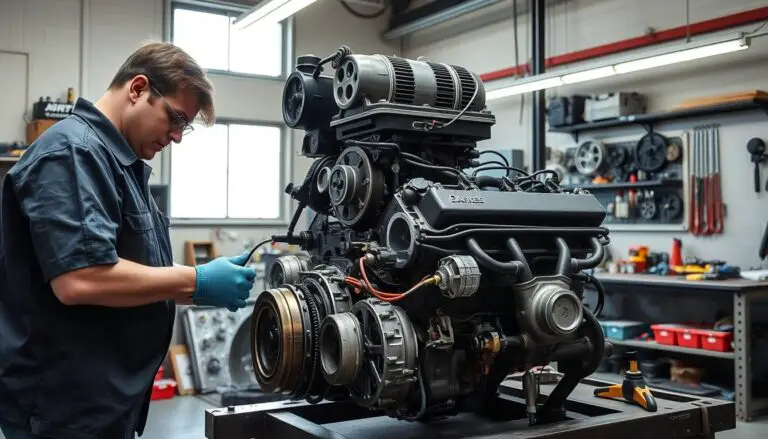Vehicles equipped with dual-zone climate control systems can sometimes experience uneven air temperature, causing discomfort for drivers and passengers. This issue can be frustrating, especially during extreme weather conditions.
Troubleshooting such issues requires understanding the underlying causes of temperature imbalance. In this article, we will guide you through the process of identifying and fixing the problem, ensuring your vehicle’s climate control system functions optimally.
Key Takeaways
- Understanding the causes of temperature imbalance in dual-zone climate control systems.
- Step-by-step guide to troubleshooting AC issues.
- Tips for maintaining optimal climate control system performance.
- Common fixes for uneven air temperature problems.
- Importance of regular vehicle maintenance for climate control systems.
Understanding Dual-Zone Climate Control Systems
Understanding how dual-zone climate control works is crucial for diagnosing temperature imbalances. Dual-zone climate control systems are designed to provide different temperatures for the driver and passenger sides, enhancing comfort during travel.
How Dual-Zone Climate Control Works
The dual-zone climate control system operates through a complex interplay of components. These include temperature sensors, blend door actuators, and climate control modules.
Components of the System
- Temperature sensors monitor the cabin temperature.
- Blend door actuators control the mix of hot and cold air.
- Climate control modules process inputs to adjust the temperature.
Normal Operation vs. Malfunction
In normal operation, the system maintains the set temperature on both sides. A malfunction can lead to temperature imbalance, where one side is significantly warmer or cooler than the other.
Common Causes of Temperature Imbalance
Temperature imbalance can stem from both mechanical and electronic issues.
Mechanical vs. Electronic Issues
Mechanical issues might include faulty blend door actuators or clogged air filters. Electronic issues could involve malfunctioning climate control modules or faulty temperature sensors.
Identifying whether the issue is mechanical or electronic is crucial for effective repair.
Why Your AC Blows Cold on Driver Side, Hot on Passenger Side: Fixes
The phenomenon of your car’s AC blowing cold air on the driver’s side and hot air on the passenger’s side is not only annoying but also indicative of an underlying problem that needs to be addressed.
The Science Behind Temperature Differences
Understanding the science behind temperature differences in dual-zone climate control systems is crucial. It involves two main aspects: airflow distribution and temperature control mechanisms.
Airflow Distribution Principles
Airflow distribution in modern vehicles is controlled by a complex system involving blend doors and actuators. These components work together to direct air through different paths, ensuring that the desired temperature is achieved on both sides of the vehicle.
Temperature Control Mechanisms
Temperature control mechanisms involve sophisticated sensors and control modules that monitor and adjust the temperature. Any malfunction in these components can lead to temperature imbalances.

Impact on Vehicle Comfort and Safety
The temperature imbalance doesn’t just cause discomfort; it can also impact safety. Two significant concerns are passenger discomfort issues and windshield fogging.
Passenger Discomfort Issues
When one side of the car is significantly colder or hotter than the other, it can lead to passenger discomfort. This discomfort can be distracting, especially during long drives.
Windshield Fogging Concerns
Moreover, improper temperature control can lead to windshield fogging, which is a significant safety concern as it impairs visibility.
Addressing the issue of your AC blowing cold on the driver’s side and hot on the passenger’s side requires understanding these factors and potentially adjusting or repairing the affected components.
Tools and Safety Precautions for DIY Repairs
Before diving into DIY repairs for your car’s AC temperature imbalance, it’s essential to gather the necessary tools and understand safety precautions. This preparation will ensure a smooth and safe repair process.
Essential Tools for AC Diagnostics and Repair
Basic Hand Tools
A set of basic hand tools, including screwdrivers, pliers, and wrenches, is indispensable for any DIY repair. These tools will help you access and manipulate various components of your car’s AC system.
Specialized AC Tools
In addition to basic hand tools, specialized AC tools such as manifold gauge sets and refrigerant leak detectors are crucial for diagnosing and repairing AC issues. These tools enable you to measure pressure, detect leaks, and perform other diagnostic tasks.

Safety Measures When Working with AC Systems
Electrical Safety
When working with electrical components of your car’s AC system, it’s vital to follow electrical safety guidelines to avoid shocks or injuries. Ensure the system is turned off before starting work.
Refrigerant Handling Precautions
Handling refrigerants requires caution due to their potential environmental impact and health risks. Always wear protective gear and follow proper procedures for handling and disposing of refrigerants.
By equipping yourself with the right tools and adhering to safety precautions, you’ll be well-prepared to tackle DIY AC repairs effectively.
Diagnosing the Problem
The first step in resolving the AC temperature imbalance issue is to diagnose the problem accurately. Diagnosing AC issues involves a systematic approach to identify the root cause of the problem.
Initial Inspection Steps
Begin by performing initial inspection steps, which include visual checks and temperature testing methods. These steps help in understanding the nature of the problem.
Visual Checks
Conduct a thorough visual inspection of the AC system, looking for signs of leaks, damaged wires, or faulty components. Check the condition of the cabin air filter, as a clogged filter can cause uneven cooling.
Temperature Testing Methods
Use a thermometer to measure the temperature of the air coming out of the vents on both sides. This will help you quantify the temperature difference and identify if the issue is with the airflow or the cooling system.
Using Diagnostic Tools
For a more detailed diagnosis, use diagnostic tools such as an OBD-II scanner. This tool can help identify any error codes related to the AC system.
OBD-II Scanner Usage
Connect the OBD-II scanner to your vehicle’s OBD-II port and follow the scanner’s instructions to retrieve any error codes. These codes will provide insights into the specific components or systems that are malfunctioning.
Interpreting Error Codes
Once you have retrieved the error codes, refer to your vehicle’s repair manual or an online database to understand what these codes mean. This will help you pinpoint the exact cause of the problem.
When to Consult a Professional
If you encounter signs of complex issues during your diagnosis, it’s advisable to consult a professional mechanic. Signs of complex issues include persistent error codes, unusual noises from the AC system, or if you’re unsure about interpreting the results.
Signs of Complex Issues
Be aware of symptoms such as inconsistent temperature control, AC compressor failure, or refrigerant leaks. These issues often require specialized tools and expertise to resolve.
Common Causes and DIY Fixes
When your car’s AC blows cold air on the driver’s side and hot air on the passenger’s side, it’s often due to a few common issues that can be easily diagnosed and fixed. Understanding these causes is crucial to resolving the temperature imbalance.
Blend Door Actuator Issues
The blend door actuator is a critical component in your car’s climate control system, responsible for regulating the temperature by mixing hot and cold air. Problems with this actuator can lead to uneven cooling.
Symptoms of Failure
Symptoms of a failing blend door actuator include inconsistent temperature control, strange noises from the dashboard, and the AC blowing hot air on one side and cold air on the other.
Testing Procedures
To test the blend door actuator, you can use a multimeter to check for electrical continuity and ensure it’s receiving the correct voltage. You can also manually adjust the actuator to see if it’s functioning properly.
Clogged Cabin Air Filter
A clogged cabin air filter can significantly impact the airflow from your car’s vents, leading to uneven cooling.
Impact on Airflow
A dirty or clogged cabin air filter restricts airflow, causing some vents to blow colder air than others. This can make your AC seem like it’s blowing cold on one side and hot on the other.
Inspection Methods
Inspecting the cabin air filter involves locating it behind your car’s glove compartment or under the dashboard, removing it, and checking for dirt or debris. If it’s dirty, replacing it with a new one can resolve the issue.
Refrigerant Level Problems
Low refrigerant levels can cause your AC to malfunction, leading to uneven cooling.
Low Refrigerant Symptoms
Symptoms of low refrigerant include the AC blowing warm air, ice forming on the AC components, and hissing sounds from the AC system.
Checking Pressure Levels
To check the refrigerant pressure, you’ll need a manifold gauge set. This tool measures the pressure in the AC system, helping you determine if the refrigerant level is low.
| Cause | Symptoms | DIY Fix |
|---|---|---|
| Blend Door Actuator Issues | Inconsistent temperature, strange noises | Test with multimeter, adjust manually |
| Clogged Cabin Air Filter | Restricted airflow, uneven cooling | Inspect and replace filter |
| Refrigerant Level Problems | Warm air, ice on AC components | Check pressure with manifold gauge |
Control Module Malfunctions
The control module is the brain of your car’s climate control system. Malfunctions can lead to erratic temperature control.
Electronic Troubleshooting
Troubleshooting the control module involves checking for software updates, ensuring proper electrical connections, and diagnosing with specialized tools.
Reset Procedures
Resetting the control module may involve disconnecting the car’s battery, using a scan tool to reset the system, or recalibrating the climate control settings.
Step-by-Step Repair Guide
To resolve the temperature imbalance in your vehicle’s dual-zone climate control system, follow this detailed repair guide. The process involves several key steps that can help you identify and fix the issue.
Replacing a Faulty Blend Door Actuator
The blend door actuator is a critical component of your car’s climate control system. When it fails, it can cause uneven cooling.
Locating the Actuator
The actuator is typically located within the HVAC system, often behind the dashboard or under the glove compartment. Consult your vehicle’s manual for the exact location.
Removal and Installation Process
To replace the actuator, you’ll need to remove the old unit and install a new one. This process may require specialized tools and some mechanical aptitude.
Cleaning or Replacing the Cabin Air Filter
A clogged cabin air filter can also cause temperature imbalances. Regular maintenance involves either cleaning or replacing this filter.
Filter Access Methods
Access to the cabin air filter varies by vehicle. Typically, it’s found behind the glove compartment or under the dashboard. Check your vehicle’s manual for specific instructions.
Cleaning vs. Replacement Decision
Some cabin air filters can be cleaned, while others need to be replaced. If your filter is dirty, assess whether it can be cleaned with compressed air or if it requires replacement.
Addressing Refrigerant Issues
Refrigerant level problems can lead to uneven cooling. Addressing these issues may require professional assistance.
Professional Recharge Considerations
If your vehicle’s refrigerant is low, it may need a recharge. This is a task best performed by a professional due to the handling of refrigerants.
Leak Detection and Repair
Leaks in the AC system can cause refrigerant loss. Detecting and repairing these leaks is crucial for maintaining the system’s efficiency.
Resetting the Climate Control Module
Sometimes, the climate control module may need to be reset to resolve issues.
Battery Disconnect Method
One method to reset the module is by disconnecting the vehicle’s battery. This can sometimes resolve software glitches.
Software Reset Options
Some modern vehicles offer software reset options through their onboard diagnostics systems. Check your vehicle’s manual or consult with a professional.
Conclusion
Proper AC function is crucial for vehicle comfort and safety. When your car’s AC blows cold air on the driver’s side and hot air on the passenger’s side, it can be frustrating. However, by understanding the causes and applying the DIY fixes discussed, you can restore balance to your vehicle’s climate control system.
A summary of the key points includes checking the blend door actuator, inspecting and cleaning or replacing the cabin air filter, addressing refrigerant level issues, and resetting the climate control module. For more complex issues or specific vehicle models like the Toyota Tacoma, you can find additional resources here to guide you through the repair process.
By following these DIY tips, you can ensure your vehicle’s AC system operates efficiently, providing a comfortable driving experience. Regular maintenance and prompt repairs are essential for extending the lifespan of your AC system and maintaining optimal vehicle comfort.
FAQ
What are the common causes of uneven air temperature in vehicles with dual-zone climate control systems?
Common causes include issues with the blend door actuator, clogged cabin air filter, refrigerant level problems, and control module malfunctions.
How do I diagnose the problem with my vehicle’s AC blowing cold on the driver side and hot on the passenger side?
Start with initial inspection steps like visual checks and temperature testing, then use diagnostic tools such as OBD-II scanners to interpret error codes.
Can I fix the issue with my vehicle’s AC temperature imbalance on my own?
Yes, DIY fixes are available for common causes such as replacing a faulty blend door actuator, cleaning or replacing the cabin air filter, and resetting the climate control module.
What safety precautions should I take when working with AC systems?
Take electrical safety precautions and handle refrigerants with care to avoid injury and environmental damage.
When should I consult a professional mechanic to fix my vehicle’s AC issue?
Consult a professional if you identify signs of complex issues, are unsure about DIY repairs, or need assistance with refrigerant handling and recharge.
How do I reset the climate control module in my vehicle?
Try the battery disconnect method or software reset options, depending on your vehicle’s make and model.
What are the symptoms of a faulty blend door actuator?
Symptoms include uneven air temperature distribution, unusual noises from the actuator, and inconsistent climate control performance.
How often should I inspect and replace the cabin air filter?
Inspect the cabin air filter regularly, and replace it as needed to maintain optimal airflow and prevent dust buildup.


